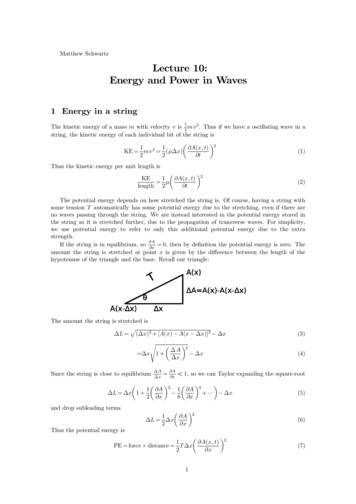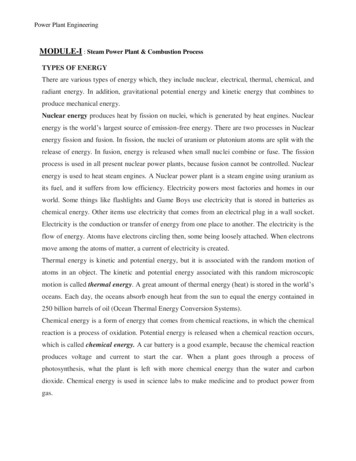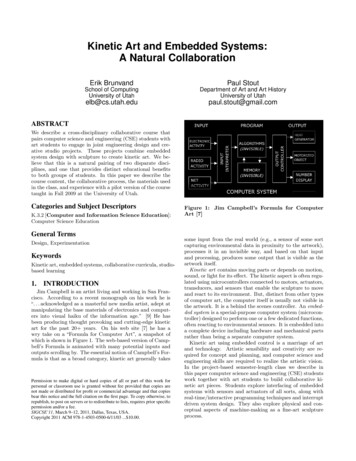
Transcription
Potential and Kinetic Energy
VELOCITYVelocity is a measure of how fast anobject is traveling in a certain direction. Example: A bus traveling North at 150 m/s Example: A car is traveling 45 mph South. Example: A truck is traveling 60 mph East.
VELOCITYVelocity distance time plus adirection
Car on a circular track may have constantspeed, but cannot maintain a constant velocityas it’s direction is always changing.
SPEED– Speed is a measure of how fast something ismoving, but there is not a directional element to it– Speed is the distance an object moves over aperiod of time.– Speed Distance Time (S D / T)
Gravity The force that pulls objectstowards each other. The force of gravity on Earthis 9.8 meters per second (m/s2) The force of gravity between two objects dependson the mass of each object and distance betweenthe two objects.
Motion Objects "tend to keep on doing what they'redoing" In fact, it is the natural tendency of objects toresist changes in their state of motion. Without some outside influence, an object inmotion will remain in motion and an object atrest will remain at rest. All objects need energy to change theirposition.
Energy Energy: is the abilityto do work Work is being donewhenever a forcemoves an object inthe same directionas the force beingapplied.
Energy means that birds can fly, tigers can roar, wind can blow, sun can shine, cars can go fast, factories can make things, light bulbs can glow and your computer can work.Without energy, there would be nothing: no life, nomovement, no light, nothing
Energy There are 2 types of energy– Potential energy– Kinetic energy Energy changes from potential to kinetic, but isnever destroyed or created.
Kinetic Energy The amount of Kinetic energy is dependent onthe mass and speed of an object. Kinetic energy is the energy of motion.
Calculating kinetic energyIf we know the mass of an object and its velocity we candetermine the amount of kinetic energy.kinetic energy 1/2 (mass of object)(velocity of object)2or KE 1/2 mv2or KE 0.5mv2The SI unit for kinetic energy is the Joule (J).A Joule is a kilogram x meters/seconds
Calculating Kinetic EnergyA 1200 kg automobile is traveling at a velocityof 100 m/s northwest.What is the kinetic energy of the automobile?KE 0.5 mv2 0.5(1200kg)(100 m/s)2 0.5(1200 kg)(10000 m/s) (600kg)(10000 m/s) 6000000 kg x m/s 6000000 Joules (J)
You TryA bicycle with amass of 14 kgtraveling at a velocity of3.0 m/s east has how muchkinetic energy?KE 0.5mv2
A bicycle with a mass of 14 kg travelingat a velocity of 3.0 m/s east has howmuch kinetic energy?KE 0.5mv2 0.5(14kg)(3m/s)2 (7kg)(3m/s)2 (7kg)(9m/s) 63 kg x m/s 63J
Potential Energy Stored energy The energy of position The amount of energy contained in an objectat rest
Determining Potential EnergyDetermined by its position and its mass(mass X gravity X height)PE (mass)(gravity)(height) mgh where m is mass in kg g is the force of gravity 9.8 m/s2 h is the height The SI unit that represents potential energy isthe Joule (J) (kg x m/s).
Example of Potential EnergyProblemA flower pot with a mass of 15 kg is sitting on awindow sill 15 meters above the ground. Howmuch potential energy does the flower pot contain? PE (mass)(gravity)(height) (15 kg)(9.8 m/s)(15 m) (147kg)(15m/s) 2205 kg X m/s 2205 Joules
You Try If the flower pot is lowered to a window sillthat is 10 meters from the ground. What is thepotential energy now?PE (mass)(gravity)(height)*gravity 9.8 m/s2
Examine an example of potentialenergy If the flower pot is lowered to a window sillthat is 10 meters from the ground. What is thepotential energy now?PE (mass)(gravity)(height) (15 kg)(9.8 m/s)(10 m) (147 kg x m/s)(10m) 1470 kg x m/s) 1470 Joules
Potential or Kinetic Energy? Moving carTree branchBent car fenderBalloon filled with airBalloon floating around a roomPerson inside a moving car
What type ofenergy does thespace shuttlemostly have afterliftoff? What type ofenergy did thespace shuttlemostly have beforeliftoff?
Law of Conservation of Energy Energy is NEVER created or destroyed; it justCHANGES forms. Energy can change from one form to another. Energy is all around us and is constantlychanging from one form to another.
Examples of Law of Conservationof Energy Parked car begins moving energy of the carchanges from potential to kinetic. A ball rolling across a field hits a rock andstops moving energy of the car changes fromkinetic to potential. A rock at the top of a hill begins to roll downthe hill energy changes from potential tokinetic.
Conversion of Potential to KineticEnergy As one type of energyincreases another typeof energy decreases. In this picture thepeople are slowingdown as they reach thetop of the hill, so aspotential energyincreases, kineticenergy decreases.
Objects slowingdown are constantlyincreasing inpotential energy anddecreasing in kineticenergy. Object speeding upare constantly inkinetic energy anddecreasing inpotential energy.
Explain how the roller coaster is an example ofthe law to conservation of energy?
Total amount of energy stays the same, energyonly changes forms as the roller coaster speedsup and slows down.
What position do you thinkthe pendulum has the mostkinetic energy? Leastkinetic energy? What position do you thinkthe pendulum has the mostpotential energy? Leastpotential energy?
Suppose the pendulum started moving atposition 1 and continued to position 5.1. Position with greatestkinetic energy?2. Position with least kineticenergy?3. Position with greatestpotential energy?4. Position with leastpotential energy?
Parked car begins moving energy of the car changes from potential to kinetic. A ball rolling across a field hits a rock and stops moving energy of the car changes from kinetic to potential. A rock at the top of a hill begins to roll down the hill energy changes from potential to kinetic.










